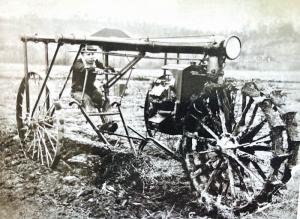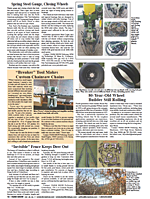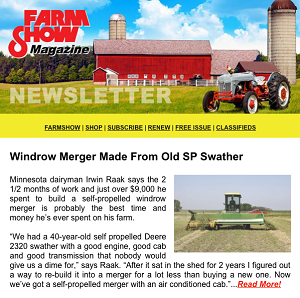Inventor Launched A 4-WD Tractor in 1919
 ✖  |
Ask modern-day farmers if they know what John Heinze was famous for, and 99 times out of 100, they’d probably say ketchup. They’d be wrong, because Henry Heinz was the ketchup guy. Only those well-versed in early 1900s tractor history would know that John O. Heinze Jr. invented, patented and built what many consider to be the very first four-wheel-drive (4-WD) tractor. The rare iron horse known simply as the Heinze 30-40 tractor was first promoted at the 1919 National Tractor Show in Kansas City.
Heinze, at the time, was in his mid-40s and reportedly had more than 60 inventions to his name. Among them were electric appliances, magnetic wheels, X-ray tubes, starters, and several automotive components. The Heinze Electric Company was a large supplier of electromagnets, ignition systems and magnetos for cars, trucks and tractors. His businesses supplied parts to nearly every automobile manufacturer, including Ford. In his spare time, Heinze focused on developing the tractor that debuted in Kansas City.
Visitors to the show were intrigued by the 30-40’s simple design. Heinze even built the small engine that transferred its power to a central driveshaft, which then powered all four cleated steel wheels through chains and sprockets. Since all four wheels were the same size and powered simultaneously, steering was done similarly to a modern-day skid steer. Pressure was applied to drums on each side of the driveshaft at different levels, so one set of wheels would receive less power, allowing the other set to turn the tractor.
The operator sat on a steel seat behind the engine under a canopy similar to those on large steam engines. There was no steering wheel, only a control lever. Because Heinze knew electronics, headlights and taillights were standard to allow fieldwork at night.
Heinze demonstrated the 30-40 at several shows, and according to written records, received orders for 25 tractors. He envisioned producing these and many more at the Traction Motor Company in Boyne City, Mich. Unfortunately, the $2,000 price tag, along with poor capitalization and stiff competition from more than 150 other manufacturers, ended the operation. The 25 tractors were supposedly never produced.
Heinze, however, wasn’t finished inventing. Writing from a winter home in Lakeland, Fla., in 1925, he sent editors of several farming magazines pictures of a new dedicated cultivator tractor he was planning to build in Alabama.
It had four narrow steel wheels, nearly 5 ft. tall. A long tubular frame, positioned nearly 6 ft. above the ground, was supported by angled bracing. A small 15-hp engine, just 11 in. long, powered the front wheels. The driver sat on a steel seat just above the center and slightly behind the rear wheels. Pictures showed the tractor cultivating rows of vegetables and pulling a narrow furrow plow similar to a horse-drawn sulky.
Always one to convey strong selling features in print ads, Heinze claimed that a farmer riding his power cultivator could do the work of three mules. The tractor also had a belt pulley to power various grinders, shellers and saws of the time. Several stories say that Heinze initially planned to produce 10 tractors per day at the Alabama plant. A larger planned expansion would eventually turn out 100 a day. No production line tractors were ever built.
Heinze, however, still wasn’t done inventing. In the late 1930s, he designed and built a model rapid transit system for Detroit that would utilize 50-passenger buses on an elevated roadway. Detroit didn’t adopt his design, but they did develop an elevated light rail system in the 1970s, long after Heinze had passed away.
In 1945, 72-year-old Heinze appeared in a Birmingham, Ala., newspaper story describing his futuristic automobile with two drive wheels in the middle of the body. Like the tractors, it was never produced. Eleven years later, in 1956, Heinze posted a classified ad in a Birmingham newspaper to sell his nearly 1,000 volumes of technical papers. It’s unknown if anyone bought the library, what became of Heinze, or where he passed away.
Despite his anonymity, many of Heinze’s inventions, especially those in electronics, 4-WD vehicle control, and skid steer technology, have been modernized and are still utilized today.

Click here to download page story appeared in.
Click here to read entire issue
Inventor Launched A 4-WD Tractor in 1919
Ask modern-day farmers if they know what John Heinze was famous for, and 99 times out of 100, they’d probably say ketchup. They’d be wrong, because Henry Heinz was the ketchup guy. Only those well-versed in early 1900s tractor history would know that John O. Heinze Jr. invented, patented and built what many consider to be the very first four-wheel-drive (4-WD) tractor. The rare iron horse known simply as the Heinze 30-40 tractor was first promoted at the 1919 National Tractor Show in Kansas City.
Heinze, at the time, was in his mid-40s and reportedly had more than 60 inventions to his name. Among them were electric appliances, magnetic wheels, X-ray tubes, starters, and several automotive components. The Heinze Electric Company was a large supplier of electromagnets, ignition systems and magnetos for cars, trucks and tractors. His businesses supplied parts to nearly every automobile manufacturer, including Ford. In his spare time, Heinze focused on developing the tractor that debuted in Kansas City.
Visitors to the show were intrigued by the 30-40’s simple design. Heinze even built the small engine that transferred its power to a central driveshaft, which then powered all four cleated steel wheels through chains and sprockets. Since all four wheels were the same size and powered simultaneously, steering was done similarly to a modern-day skid steer. Pressure was applied to drums on each side of the driveshaft at different levels, so one set of wheels would receive less power, allowing the other set to turn the tractor.
The operator sat on a steel seat behind the engine under a canopy similar to those on large steam engines. There was no steering wheel, only a control lever. Because Heinze knew electronics, headlights and taillights were standard to allow fieldwork at night.
Heinze demonstrated the 30-40 at several shows, and according to written records, received orders for 25 tractors. He envisioned producing these and many more at the Traction Motor Company in Boyne City, Mich. Unfortunately, the $2,000 price tag, along with poor capitalization and stiff competition from more than 150 other manufacturers, ended the operation. The 25 tractors were supposedly never produced.
Heinze, however, wasn’t finished inventing. Writing from a winter home in Lakeland, Fla., in 1925, he sent editors of several farming magazines pictures of a new dedicated cultivator tractor he was planning to build in Alabama.
It had four narrow steel wheels, nearly 5 ft. tall. A long tubular frame, positioned nearly 6 ft. above the ground, was supported by angled bracing. A small 15-hp engine, just 11 in. long, powered the front wheels. The driver sat on a steel seat just above the center and slightly behind the rear wheels. Pictures showed the tractor cultivating rows of vegetables and pulling a narrow furrow plow similar to a horse-drawn sulky.
Always one to convey strong selling features in print ads, Heinze claimed that a farmer riding his power cultivator could do the work of three mules. The tractor also had a belt pulley to power various grinders, shellers and saws of the time. Several stories say that Heinze initially planned to produce 10 tractors per day at the Alabama plant. A larger planned expansion would eventually turn out 100 a day. No production line tractors were ever built.
Heinze, however, still wasn’t done inventing. In the late 1930s, he designed and built a model rapid transit system for Detroit that would utilize 50-passenger buses on an elevated roadway. Detroit didn’t adopt his design, but they did develop an elevated light rail system in the 1970s, long after Heinze had passed away.
In 1945, 72-year-old Heinze appeared in a Birmingham, Ala., newspaper story describing his futuristic automobile with two drive wheels in the middle of the body. Like the tractors, it was never produced. Eleven years later, in 1956, Heinze posted a classified ad in a Birmingham newspaper to sell his nearly 1,000 volumes of technical papers. It’s unknown if anyone bought the library, what became of Heinze, or where he passed away.
Despite his anonymity, many of Heinze’s inventions, especially those in electronics, 4-WD vehicle control, and skid steer technology, have been modernized and are still utilized today.
To read the rest of this story, download this issue below or click
here to register with your account number.







